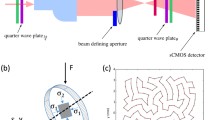Abstract
An interformetric method of obtaining the two principal stresses separately in two-dimensional stress distribution is described. An analytical interpretation is given of the relation between the stress-strain state of a transparent elastic plate and the light intensity of the plate observed through the Mach-Zehnder interferometer. The isopachic fringes which give the distribution of the sum of the principal stressesσ 1 +σ 2 are modulated by simultaneous appearance of the isochromatic fringes which related to the distribution of the difference of principal stressesσ 1 -σ 2. Accordingly, a single pattern obtained by this method provides sufficient information for evaluating the two principal stresses separately.
As examples, a few two-dimensional cases are treated and some practical procedures for carrying out the experiment are described. The feasibility of this method for the general three-diensions frozen-stress model is also discussed.
Similar content being viewed by others
References
Favre, H., “Surune nouvelle méthode optique de détermination des tensions intérieures,”Rev. optique, 8, 193–213, 241–261, 289–307 (1929).
Fabry, C., “Sur une nouvelle méthode pour l’étude expérimentale des tensions élasltique,”Compt. rend., 190, 457–460 (1930).
Brahtz, J. H. A. andSoehrens J.E., Direct Optical Measurements of Individual Principal Stresses,”Jnl. Appl. Phys., 10, 242–247 (1939).
Frocht, M. M., “Isopachic Stress Patterns,”Jnl. Appl. Phys., 10, 248–257 (1939).
Sinclair, D. and Bucky, P. B., “Photoelasticity and Its Application to Mine-Pillar and Tunnel Problems,” Am. Inst. Mining and Met. Eng. Techn. Publ. 1140 (1940).
Sinclair, D., “Interferometer Method of Plane Stress Analysis,”Jnl. Opt. Soc. Am.,30,511–513 (1940).
Post, D., “A New Photoelastic Inteferometer Suitable for Static and Dynamic Measurements,”Proc. SESA 12, 1, 191–212 (1954).“Photelastic Evaluation of Individual Principal Stresses by Large Field Absolute Retardation Measurements,” Proc. SESA, 13, 2, 119–132 (1956). “Isochromatic Fringe Scharpening and Fringe Multiplication in Photoelasticity,” Proc. SESA. SESA, 12, 2, 143–156 (1955).
Fawre, H. and Schumann, W., “A Photoelectric-Interferometric Method to Determine Separately the Principal Stress in Two-dimensional States and Possible Applications to Surface and Thermal Stresses,” Photoelasticity, Proc. International Symposium, 1961, Frocht M. M., Ed., Pergamon Press Pub., 3–25, 1963.
Coker, E. G. andFilon, L. N. G., A Treatise on Photo-Elasticity, University Press, Cambridge, 215, 1931.
Dose, A. andLandwehr, R., “Zur Bestimmung der Isopachen (Lininen gleicher Hauptspannungssumme) in der Spannungsoptik,”Naturwissenschaften, 36, 342–343 (1949).
Mesmer, G., “The Interference Screen Method for Isopachic Patterns (Moiré Method),”Proc. SESA, 13, 2, 21–26 (1956).
Pirard, A., “Considerations sur la méthode du moiré en photoélasticité,”Revue Universelle des Mines, 9 série 16, 4, 177–200 (1960).
Pockels, F., Lehrbuch der Kristalloptik, B. G. Teubner, Leipzig u. Berlin, 33, 1906.
Ramachandran G. N. and Ramaseshan, S., “Crystal Optics,” Handbuch der Physik, Band XXV/1, Springer Verlag, 74, 1961.
Kuske, A., “Das Kunstharz Phenolformaldelhyde in der Spannungsoptik,”Forsch. Geb. Ing-Wes., 9, 139–149 (1938).
Frocht, M. M., Jnl. Appl. Mech. Rev., 3, 2, 38 (1950).Froncht, M. M. and Guernsey, R., Jr., “A Special Investigation to Develop a General Method for Three-Dimensional Photoelastic Stress Analysis,” National Advisory Committee for Aeronautics, Techn. Note 2822 (1952).
Hiltscher, R., “Polarisationsoptische Untersuchung des räumlichen Spannungeszustandes im konvergenten Licht,”Forsch. Geb. Ing-Wes. 9, 91–103 (1939).
Jessop, H. T., “A Tilting Stage Method for Three-Dimensional Photoelastic Investigations,”Brit. J. Appl. Phys. 8, 30–32 (1957).
Author information
Authors and Affiliations
Rights and permissions
About this article
Cite this article
Nisida, M., Saito, H. A new interferomemtric method of two-dimensional stress analysis. Experimental Mechanics 4, 366–376 (1964). https://doi.org/10.1007/BF02322795
Issue Date:
DOI: https://doi.org/10.1007/BF02322795




